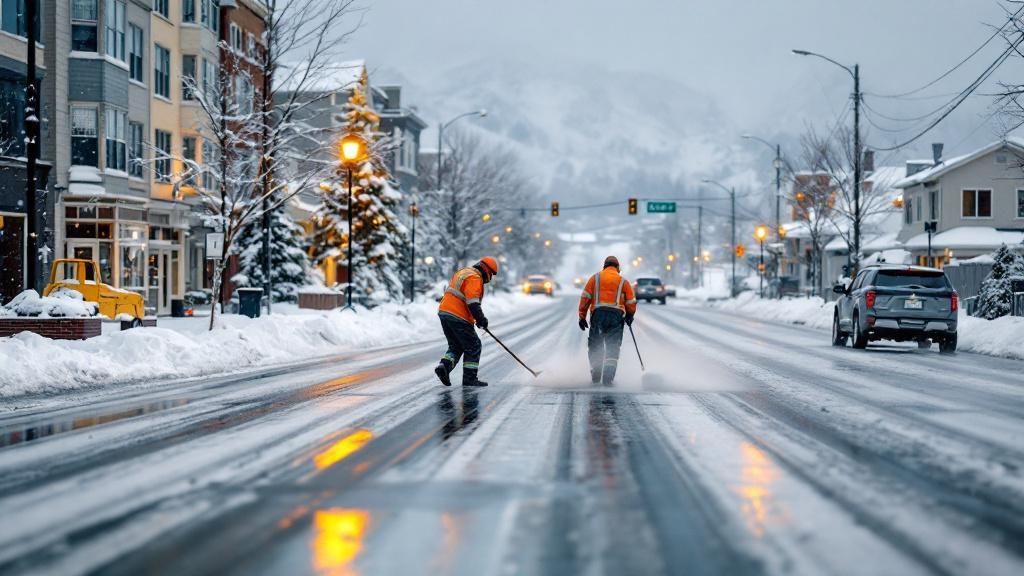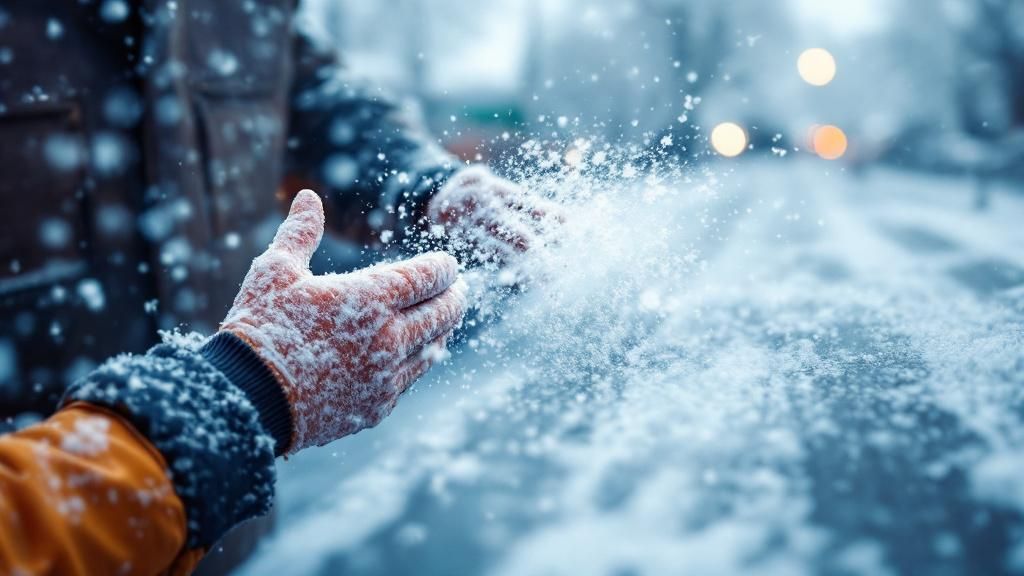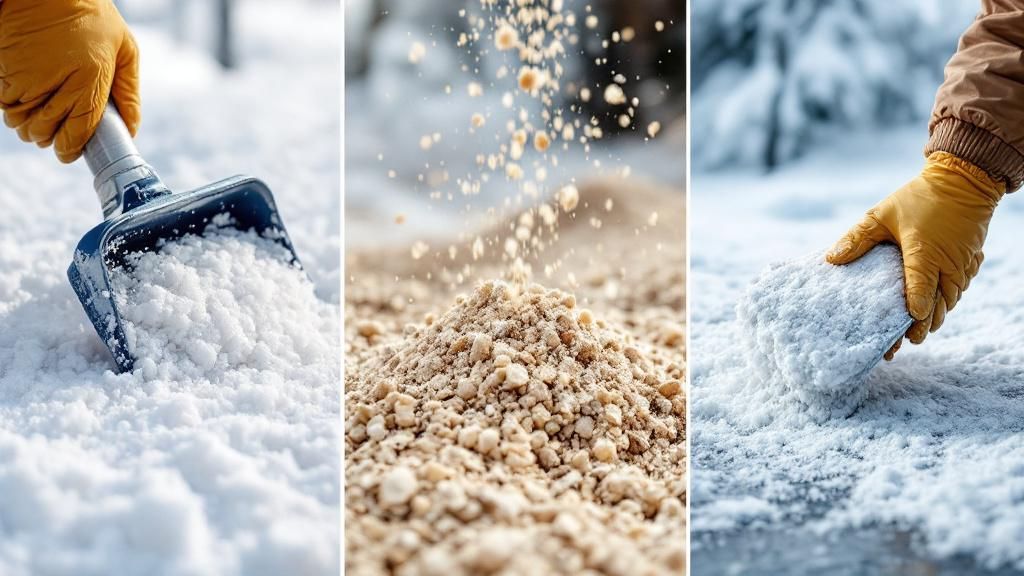
De-icing Solutions for Anchorage Snow Management
Key Takeaways
-
Salt remains the most effective de-icing agent for cost-efficiency and ice-melting capability.
-
Sand improves traction, not melting—ideal for walkways and slopes.
-
Beet juice and magnesium chloride can be used in select conditions with less damage to surfaces.
-
Combination strategies (e.g., salt + sand) improve traction while reducing overall chemical use.
-
De-icing is only effective with timely application and proper surface preparation.
Managing snow and ice in Anchorage, Alaska is more than a seasonal hassle—it’s a necessity for keeping properties safe, accessible, and operational. From commercial parking lots to steep driveways, choosing the right de-icing solution means fewer slip hazards, better vehicle traction, and reduced liability risks.
This guide cuts through the noise and explores the most practical de-icing strategies suited for Anchorage’s unique conditions, without overpromising expensive tech or vague eco-talk.
The Real Deal on Salt, Sand, and Combo Applications
The backbone of any snow and ice control strategy is salt. It’s inexpensive, widely available, and works well in most Anchorage temperatures. However, salt alone isn’t perfect. At very low temps, it loses effectiveness, and overuse can corrode surfaces and nearby vegetation.
Practical De-icing Mixes:
-
Rock Salt (Sodium Chloride) – Melts ice down to about 15°F; best used on pavement and large surface areas.
-
Sand – Offers traction, not melting. Ideal for sloped driveways or areas where immediate grip is more important than melting.
-
Salt + Sand Mix – Combines melting and grip for cost-efficient application.
Property owners often rotate these combinations depending on snowpack, surface type, and foot traffic.
Understanding Surface Needs: Not All Pavement Is Equal
De-icing strategies vary depending on surface type:
-
Asphalt is more forgiving and absorbs heat well, speeding up melting.
-
Concrete can be more prone to cracking when exposed to freeze-thaw cycles, especially when salt is over-applied.
-
Gravel driveways or paths benefit more from sand for traction than from chemical melting.
Knowing the surface helps you match the right de-icing material to minimize long-term damage.
When to Apply: Timing Is Everything
De-icing products aren’t just about what you use—they’re about when you use them.
-
Pre-treatment before a storm helps prevent ice bonding and makes removal easier.
-
During a storm, reapplication may be needed depending on accumulation.
-
Post-storm de-icing helps tackle leftover patches and black ice formation.
Pro tip: Always clear snow down to the surface before applying de-icers. Otherwise, you’ll just waste product on top of fluff.

Straightforward Alternatives That Don’t Require a Lab
Tired of hearing about beet juice, cheese brine, and other oddball solutions? Some eco-alternatives do work—but usually in specific scenarios, or when applied by large municipal crews.
Viable Alternatives (for Anchorage-scale usage):
-
Magnesium Chloride – Less corrosive than rock salt and works in colder temps (~5°F). A good choice for decks, walkways, or sensitive plant zones.
-
Calcium Magnesium Acetate (CMA) – Expensive, but gentle on concrete and landscaping.
Unless you’re managing a large commercial complex with sensitive landscaping, most homeowners and businesses still find traditional methods more cost-effective.
Snow Fence, Drainage, and Ground Prep
Before snow even hits the ground, physical preparation makes de-icing more effective.
-
Snow fencing helps redirect and manage drifting.
-
Proper grading and drainage prevent refreezing puddles.
-
Textured surfaces or anti-slip mats reduce the need for constant chemical treatment.
Anchorage properties with these passive strategies in place usually require less product and labor throughout winter.
Avoid These De-icing Mistakes
Even experienced Anchorage property owners can fall into common traps:
-
Overapplying salt – More isn’t better. Excess can corrode concrete and kill nearby grass.
-
Waiting too long – Delay gives snow time to bond and turn into hard ice.
-
Ignoring small problem areas – Shady corners and building overhangs often refreeze first.
-
Using the wrong product on delicate areas like composite decks, wooden stairs, or paver patios.
The best defense is consistent observation and minor touch-ups after every freeze.

Why Anchorage Properties Need a Smart Plan
Every winter is different. But over time, the wear and tear on your property adds up. Cracked concrete, slippery walkways, and damaged landscape beds all come back to how you handled snow and ice.
A consistent, smart de-icing strategy doesn’t just prevent slips—it preserves your investment.
Whether you’re managing a retail property, apartment complex, or residential driveway, having a professional team with a tested Anchorage-ready snow strategy can make a difference.
Companies like Titan understand the specific freeze-thaw cycles, surface types, and runoff patterns unique to the region—and they tailor snow removal and de-icing plans accordingly.
Choosing Titan for Snow Management Services
From commercial lots to residential sidewalks, Titan provides snow removal and de-icing solutions that prioritize safety, surface longevity, and cost-efficiency.
Their team evaluates your surface type, snow load patterns, and property layout to recommend a treatment plan that makes sense—not one that depends on fancy buzzwords.
If you’re in Anchorage and need consistent snow and ice control throughout winter, Titan brings local insight and reliable equipment to keep your property moving.
FAQs
Does sand melt ice?
No, sand doesn’t melt ice. It provides traction to reduce slipping, especially useful on walkways and sloped surfaces.
What’s the most effective de-icing agent for Anchorage?
Rock salt is widely used for its affordability and effectiveness down to 15°F. For colder conditions, magnesium chloride is a better option.
How can I reduce damage from de-icing chemicals?
Apply only as needed, sweep up residual material after storms, and use sand or magnesium-based products near plants or concrete.
Is beet juice really a good de-icer?
Beet juice can help lower the freezing point when mixed with other agents, but it’s not practical for most small-scale Anchorage applications.
When should I start applying de-icer?
Before a storm hits—pre-treatment works best. Follow up during and after storms as needed, especially in shaded or high-traffic areas.